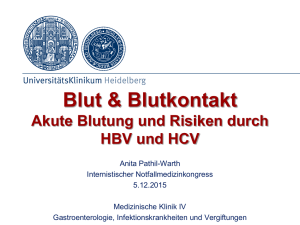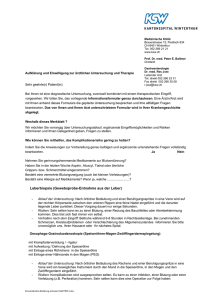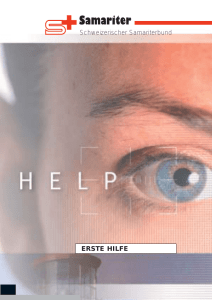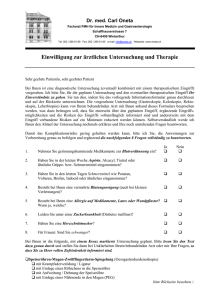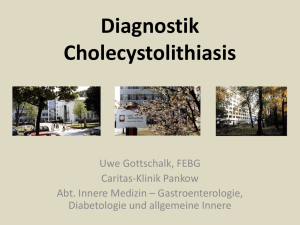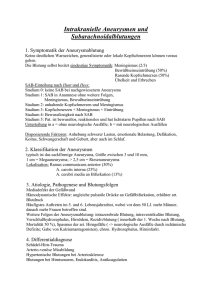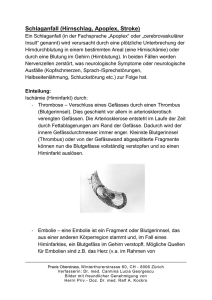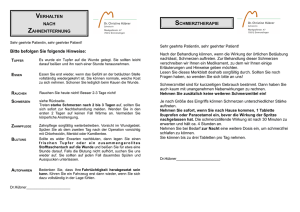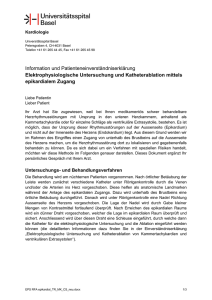Gastrointestinale Blutung
Werbung
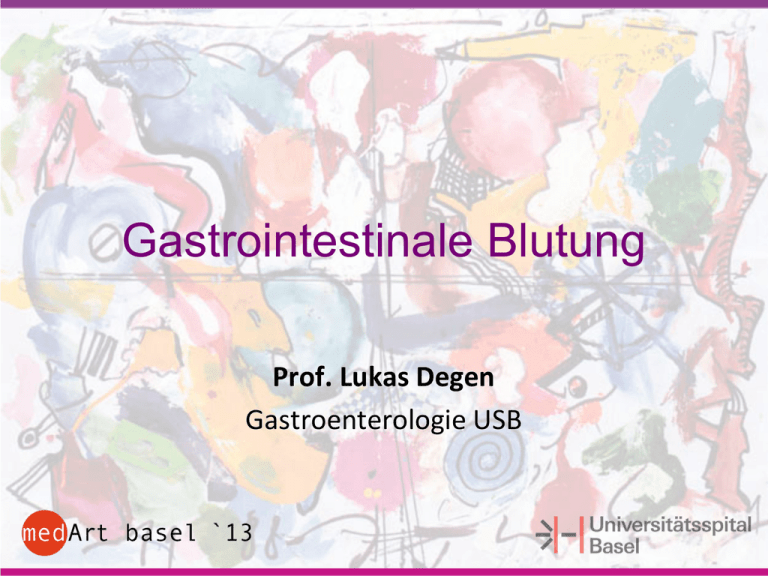
Gastrointestinale Blutung Prof. Lukas Degen Gastroenterologie USB Gastrointestinale Blutung Hospitalisationen pro Jahr (UK 2007) Hauptdiagnose 390‘000 Zweitdiagnose 600‘000 Kosten (USA 2009) Hauptdiagnose 1.7 Milliarden US Dollar Peery et al., Gastroenterology 2012 Dalton et al., Oxford, National Blood Service 2007 Gastrointestinale Blutung Obere Blutung Untere Blutung Ligamentum Treitz Blutungsdefinitionen Sichtbare Blutung - Hämatemesis - Melaena - Hämatochezie Okkulte Blutung - Unbemerkter Blutung - Geringer kontinuierlicher Blutverlust - Eisenmangelanämie Obskure Blutung - ohne identifizierbare Ursache - sichtbare oder okkulte Blutung GI- Blutung Ereignisse 2500 Obere 2000 1500 Unklar 1000 500 Untere 0 1996 1998 2000 2002 2004 Jahr Lanas et al., Am J Gastroenterol 2009 Obere GI- Blutung Likelihood Ratio Melaena bei der Untersuchung Harnstoff/Kreatinin Quotient >30 Frühere obere GI- Blutung Anamnese von Melaena Alter <50 Jahre 25 08 06 06 04 Blutkoagel im Stuhl Frühere untere GI- Blutung 0.05 0.17 Srygley et al., JAMA 2012 Untere GI- Blutung Inzidenz 30. Lebensjahr 1/100‘000 90. Lebensjahr >200/100‘000 Verlauf Spontanes Sistieren in 80% Rezidivblutung in 25% Imdahl, Langenbeck‘s Arch Surg 2001 Zuckerman and Prakash, Gastrointest Endosc 1998 Longstreth, Am J Gastroenterol 1997 Risiko Mortalität Spitalaufenthalt Obere GI Blutung 06% 08 Tage Untere GI Blutung 09%* 12 Tage Unklar 10%* 08 Tage *p<0.001 Lanas et al., Am J Gastroenterol 2009 Obere GI- Blutung Risiko Mortalität - Alter >65 Jahre Schock ASA Klassifikation Komorbiditäten - Erhöhter Harnstoff - Kreatinin >150 μmol/L - Erhöhte ASAT/ALAT Skores - Rockall - Blatchford - AIMS65 Barkun et al., Ann Intern Med 2003 Untere GI- Blutung Risiko Parameter - Puls ≥100/Min./systolischer BD ≤115 mmHg Synkope Weiches Abdomen Klinik persistierender Blutung Aspirin (≥81 mg tgl.) >2 Komorbiditäten Risiko einer schweren Blutung >3 84% 1-3 43% 0 09% Strate et al., Arch Intern Med 2003 Strate et al., Am J Gastroenterol 2005 Ätiologie Divertikel Entzündlich (IBD,Infektion, Ischämie) Neoplasia Koagulopathie Benigne anorektale Krankheit Arteriovenöse Malformationen Inzidenz (%) 40 21 14 12 11 2 Vernava, Surg Res Commun 1996 Ätiologie Obere GI- Blutung - Ursache in 10-15% Dünndarm - Ursache in 3-5% - Angiodysplasien 70-80% Koagulopathie - selten spontane Blutung - Meist spezifische Mukosaläsion - Abklärung wie bei normaler Gerinnung Vernava et al., Dis Colon Rectum 1997 Ätiologie und Alter <40 Lj Meckel Divertikel Chron. entzündliche Darmkrankheit Polypen 40-60 Lj Kolondivertikel Chron. entzündliche Darmkrankheit Neoplasie >60 Lj Kolondivertikel Angiodysplasie Neoplasie Enns, Can J Gastroenterol 2001 Divertikulose Prävalenz 50. Lebensjahr 80. Lebensjahr 30% 60% Pathophysiologie Divertikel im distalen Kolon 70-90% Lewis, J Clin Gastroenterol 2008 Divertikelblutung Blutung vom proximalen Kolon Spontanes Sistieren >60% >90% Risiko einer Rezidivblutung - nach 1 Blutung - nach 2 Blutungen >25% >50% Schwere Blutung ≤5% Poncet et al., Aliment Pharmacol Ther 2010 Longstreth Am J Gastroenterol 1997 Initiale Beurteilung Schweregrad der Blutung Blutverlust <10% 10-20% 20-25% Hämodynamik kein Effekt Orthostase Schock Rockey, Gastroenterol Clin N Am 2005 Abklärung Anamnese Wochen) - Medikamente: NSAR, Antikoagulation etc. - Frühere Blutungsepisoden - Koloskopie/Polypektomie (<2 - Koagulopathie - Malignome Klinik - Abdomen - Anorektum Barnert, Messmann, Nat Rev Gastroenterol Hepatol 2009 Koloskopie Hämatochezie mit Zeichen schwerer Blutung 1. Gastroskopie 2. - Notfall-Koloskopie innerhalb 12 Std. 2. - Elektive Koloskopie innerhalb 36-60 Std. Keine Unterschiede - weitere Blutungsepisoden - weitere Interventionen - Transfusionen - Hospitalisationsdauer Laine, Shah, Am J Gastroenterol 2010 Koloskopie Probleme der Notfall- Koloskopie - Qualität der Kolon- Vorbereitung - Zeitaufwand - Selten aktive Blutungsquelle - Sedation - Personelle und infrastrukturelle Ressourcen Lhewa, Strate, World J Gastroenterol 2012 CT Angiographie Blutungen 0.3-0.5 mL/Minute (≈2 Einheiten Blut/24 Std.) Sensitivität 60% Genauigkeit 82% Probleme - falsch positive Befunde - keine Therapie Strate, Naumann, Clin Gastroenterol Hepatol 2010 Angiographie Blutung ≥0.5m L/Minute (≈3 Einheiten Blut/24 Std.) Positive Angiographie - syst. BD <90 mmHg - 5 Einheiten Blut/24Std. Sensitivität - 25-70% Komplikationen - leicht: - schwer: Vorteil Diagnose und Therapie 26% 17% Strate, Naumann, Clin Gastroenterol Hepatol 2010 Szintigraphie Blutmenge 0.05-0.1 mL/Minute (≈1 Einheit Blut/48 Std.) Sensitivität 79-97% Genauigkeit 66% Probleme - falsche Befunde - nicht überall vorhanden - keine Therapie Currie et al., J Clin Gastroenterol 2011 Kapselendoskopie Befunde Offensichtliche Blutung - Bedeutende Befunde - Unbedeutende Befunde - Negativ Probleme - 38-93% 60% 14% 26% inkomplette Untersuchung ≤35% Zeitdauer Erkennen der Blutungsursache keine Therapie Carretero et al., World J Gastroenterol 2008 Carey et al., Am J Gastroenterol 2007 Hämatochezie Hämodynamik instabil - Stabilisierung + Gastroskopie Koloskopie - + Endoskopische Therapie Blutung lokalisiert Angiographie +/- Embolisation Chirurgie Barnert, Messmann, Nat Rev Gastroenterol Hepatol 2009 Hämodynamik stabil Koloskopie Blutung lokalisiert Negativ Zu schwere Blutung Endoskopische Therapie Gastroskopie ohne Blutungsquelle Kapselendoskopien ohne Erfolg Angiographie +/- Embolisation Chirurgie Barnert, Messmann, Nat Rev Gastroenterol Hepatol 2009 Literatur SAL Gastrointestinale Blutung Burden of gastrointestinal disease in the United States: 2012 update. Peery AF, Dellon ES, Lund J, Crockett SD, McGowan CE, Bulsiewicz WJ, Gangarosa LM, Thiny MT, Stizenberg K, Morgan DR, Ringel Y, Kim HP, Dibonaventura MD, Carroll CF, Allen JK, Cook SF, Sandler RS, Kappelman MD, Shaheen NJ. Gastroenterology. 2012;143:1179-87. International consensus recommendations on the management of patients with nonvariceal upper gastrointestinal bleeding. Barkun AN, Bardou M, Kuipers EJ, Sung J, Hunt RH, Martel M, Sinclair P. International Consensus Upper Gastrointestinal Bleeding Conference Group. Ann Intern Med. 2010 19;152:101-13. Natural history of acute colonic diverticular bleeding: a prospective study in 133 consecutive patients. Poncet G, Heluwaert F, Voirin D, Bonaz B, Faucheron JL. Aliment Pharmacol Ther. 2010;32:466-71. Randomized trial of urgent vs. elective colonoscopy in patients hospitalized with lower GI bleeding. Laine L, Shah A. Am J Gastroenterol. 2010;105:2636-41 The role of colonoscopy and radiological procedures in the management of acute lower intestinal bleeding. Strate LL, Naumann CR. Clin Gastroenterol Hepatol. 2010;8:333-43 Diagnosis and management of lower gastrointestinal bleeding. Barnert J, Messmann H. Nat Rev Gastroenterol Hepatol. 2009;6:637-46. Gastrointestinal bleeding in the elderly. Yachimski PS, Friedman LS. Nat Clin Pract Gastroenterol Hepatol. 2008;5:80-93. Role of videocapsule endoscopy for gastrointestinal bleeding. Carretero C, Fernandez-Urien I, Betes M, Muñoz-Navas M. World J Gastroenterol. 2008 14;14:5261-4.


